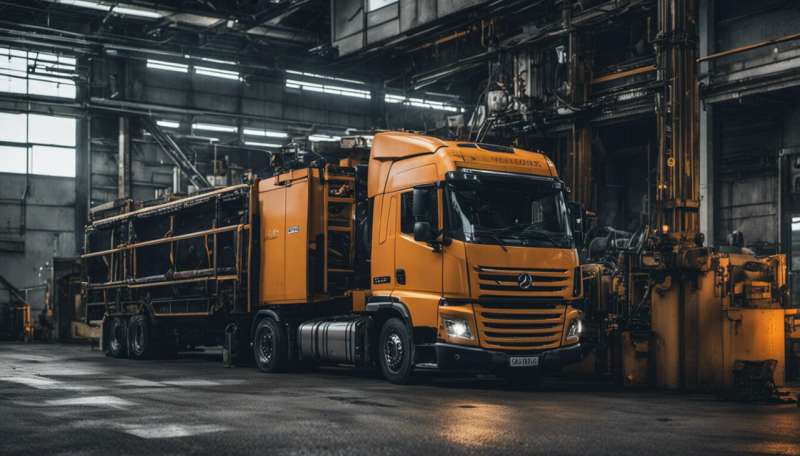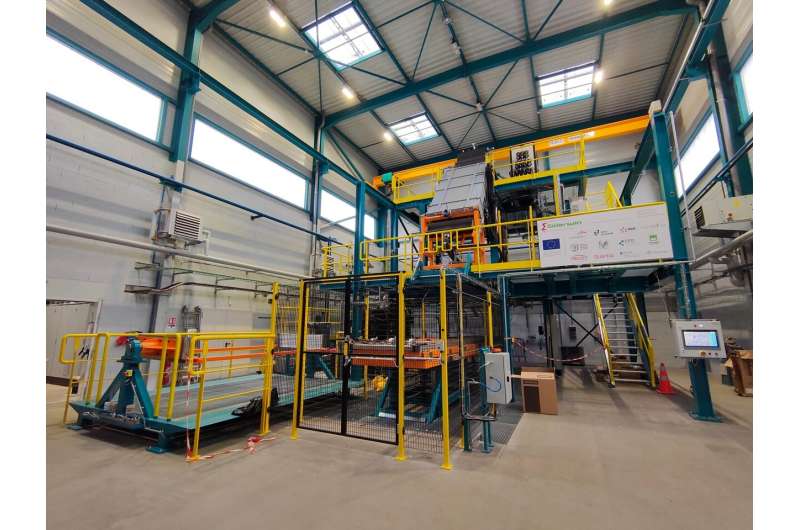This article has been reviewed according to Science X's editorial process and policies. Editors have highlighted the following attributes while ensuring the content's credibility:
fact-checked
trusted source
proofread
European steel industry seeks green credentials to match its economic, political weight

A building block of modern society and a sizeable contributor to climate change, steel is prompting a hunt for cutting-edge technologies to decarbonize the sector.
On an industrial test site near the north-eastern French city of Metz, a machine the size of a small two-story house is producing iron plates. With this process, Europe is taking a key step in fighting climate change.
What is taking place is steel production through electrolysis, a new method that avoids heavy-polluting coal and reduces emissions of greenhouse gases including CO2. Using these new technologies, steel companies are hoping to decarbonize their own industry.
Pilot plant
The French pilot plant of Luxembourg-based ArcelorMittal, the world's second-largest steel producer, emerged through the EU-funded SIDERWIN project, which ended this past March after more than five years.
While modest in the grand scheme of things, producing a tiny fraction of the steel volumes of a normal plant, the pilot site has big expectations riding on it.

"During 2025 and 2025, we will develop our first small industrial plant," said Valentine Weber-Zollinger, an ArcelorMittal engineer who coordinated SIDERWIN. "Our ambition is to have this pilot plant in operation in 2027. After that, we need to increase the size to that of a full-scale steel mill, which would happen by 2030."
Industrial emissions including from steel production contribute significantly to global warming worldwide and in Europe.
Crucial for everything from cars and fridges to bridges and railways, steel is responsible for about 7% of global and 5% of European CO2 emissions. By comparison, aviation accounts for around 2.5% of worldwide CO2.
Steel manufacturers have been in the sights of European climate legislators since 2005, when the EU began capping greenhouse gases from factories as well as power plants through the world's biggest emissions-trading system, or ETS.
Since then, emitters under the ETS have faced steadily tighter annual caps as the EU pursues climate-neutrality by 2050. The stricter regulation has in turn prompted steel manufacturers in Europe to step up the hunt for greener production methods.
Clout and climate
In Europe, the sector has annual turnover of around €125 billion and employs more than 300,000 people, according to industry association Eurofer.
Europe's steel industry also has political importance rooted in the 1951 European Coal and Steel Community. The ECSC marked a first step toward European integration after World War II.
European climate ambitions along with the steel industry's economic and political weight in Europe led the EU this year to approve an unprecedented trade-policy plan known as the Carbon Border Adjustment Mechanism, or CBAM. It'll impose a levy on EU imports of goods including steel if they come from countries where manufacturers are spared the climate-protection costs faced by producers in the ETS.
"Steel production is one of the most energy-intensive industrial processes in existence," said Richard Porter, senior research associate at the University College London. "It produces a lot of CO2 emissions, so it's crucial that we decarbonize the sector as fast as possible."
Dirty work
Steel production emits CO2 chiefly in three ways. In a typical steel plant, coal is used to produce coke, which in turn is a main energy source in blast furnaces.
Coke is also used as a so-called reducing agent. In this role, coke is burnt together with iron and creates a chemical process in which oxygen is removed from the iron ore and produces molten iron that is eventually used to make steel.
On top of that, a steelworks uses a lot of electricity, most of which is generated on site but for now still comes from CO2-producing sources. Nevertheless, the primary emissions source in steelmaking is the use of coal.
So far, the EU steel industry has focused its decarbonization strategy mainly on hydrogen-based possibilities, according to the European Commission's Joint Research Center.
For example, Sweden-based H2 Green Steel plans to use a plant in the northern part of the country to produce the metal with green hydrogen—powered by fossil-free electricity—rather than with coal. The expectation is that CO2 emissions could be reduced by as much as 95% compared with traditional steelmaking.
Carbon capture
Other options include not just electrolysis but also so-called carbon capture, which is the focus of the work by Porter.
"We want to capture the majority of the CO2 from a steelworks," he said. "We target the gases that contain CO2 and use chemical processes to capture it."
Porter is part of the EU-funded C4U project, which is developing this technology. Running for four years through March 2024, the project aims to test the research in steelworks in Belgium, Spain and Sweden.
If the system works and manages to scale, it would make a big difference. C4U aims for full commercial implementation in 2030.
"Our aim is to capture and mitigate around 90% of the emissions of a steelworks," Porter said.
The captured CO2 would then be either stored—for example in depleted oil and natural gas fields under the sea—or used in other industrial processes, such as cement production, where the carbon isn't re-emitted.
Carbon-capture technology, however, has its fair share of critics because it doesn't require a fundamental rethink of how to make steel in the way that, for example, electrolysis does. Producers can simply pursue business as usual, equipping factories with carbon-capture equipment and prolonging dirty production.
Porter is aware of these critiques.
"Hopefully carbon capture can be a steppingstone to different types of steel production," he said.
Retro-fitting steelworks with carbon-capture technology can reduce CO2 emissions as a stop-gap measure while fundamentally cleaner forms of steel production are introduced.
Current reactions
That's where SIDERWIN's activity enters the picture. Instead of coal being used as a reducing agent, electricity would do this job.
"There are two electrodes that we submerge in a fluid called an electrolyte," said Weber-Zollinger of ArcelorMittal. "When you add current, it will create a reaction that can separate iron from the oxygen in the iron mineral source."
Using electrolysis in this way would reduce the bulk of CO2 emissions from steel production. The question is whether the process can be scaled up.
The project participants built a pilot plant to find out.
In a previous project, ArcelorMittal had already constructed a pilot plant that could produce a plate of around three to four kilograms of iron, which can eventually be transformed into steel. The new system produces plates of around one square meter that weigh between 20 kg and 50 kg.
"Our approach will allow us to drastically reduce CO2," said Jean-Paul Allemand, research center manager of ArcelorMittal. "But there will still be remaining emissions that we will need to capture."
All of which means research in this whole area in Europe will remain active on numerous fronts.
"We need to get a move on—both with the deployment of carbon capture as with new production methods," said Porter of C4U. "There are a lot of pilots and exciting developments. But more is needed."


















